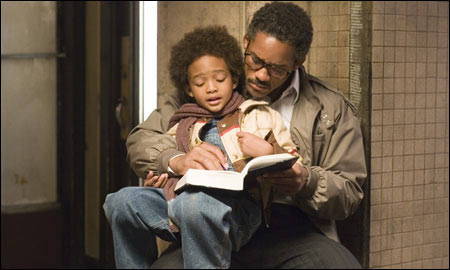Best and Worst Films of 2006 (of the 98 I saw...)
As usual, a flurry of promising films is being released before the end of the year so they can be considered for the Golden Globes Awards (January 15, 2007, NBC) and the Academy Awards (February 25, 2007): Miss Potter, The Good German, Dreamgirls, Children of Men, Perfume, Notes on a Scandal, the Painted Veil, Letters from Iwo Jima, etc. Volver, with Penelope Cruz, is getting a lot of buzz, but it’s not in wide release. Alas, I have not had the opportunity to see these films yet so I cannot include them on by best and worst film list of 2006. (I will add to this list as I see the films).
My basic criteria for judging films (as stated in my column in St. Anthony Messenger, 2006) are:
• The degree to which the filmmaker tells the story through the creative use of image and sound;
• How well the main character grows as a person and member of the human family;
• The promotion of the gospel values of human dignity, family and community, justice, peace and fair representation of cultures, races, genders, ages, religious faiths and spiritualities;
• The ability to entertain
Over 750 films were released commercially in 2006; I saw 98. (According to http://www.the-numbers.com/movies/index2006.php, 770 films will have been released by December 31.)
My Best Films List for 2007
(All of these deserve award consideration)
Babel (Best Director, Best Screenplay, Best Supporting Actress Rinko Kikuchi)
Blood Diamond (Best Screenplay; Best Actor Leonardo di Caprio; Djimon Hounsou for Best Supporting Actor)
Catch a Fire (Best Actor Derek Luke)
The Departed (Best Director!! Martin Scorsese; Best Actor Leonardo di Caprio)
Dreamgirls (Saw it yesterday; it's moving, musical, and magic. Jennifer Hudson is remarkable; Eddie Murphy - who knew?)
The Good Shepherd (Best Film; Matt Damon for Best Actor)
An Inconvenient Truth (Best Documentary)
The Last King of Scotland (Forest Whittaker, Best Actor, and James McAvoy for Best Supporting Actor)
Little Miss Sunshine (Best Independent Film!)
Miss Potter *** (Best Cinematography, Screenplay, Actress)
The Nativity Story (Mike Rich for Best Screenplay and Oscar Isaac as Best Actor)
Notes on a Scandal -The UK provides a triple threat this year with this film, the Queen, and Miss Potter. All films about women and all excel
The Queen (Helen Mirren for Best Actress and Stephen Frears for Direction)
Stranger than Fiction (Best Screenplay and Maggie Gyllenhaal for Best Supporting Actress)
Water (Best Foreign Film)
Honorable Mention
Yes, there are a lot of films on this list… and I am glad I got to see each one; the ones tagged with an ** deserve award consideration, whether Golden Globe, People’s Choice, a Gabriel, or an Oscar). I reviewed most of these films in St. Anthony Messenger (www.AmericanCatholic.org) this year, but was not able to keep up with my blog for a few months….
Akeelah and the Bee **
The Ant Bully**
The Beauty Academy of Kabul
Cars **
Catch a Fire **
Cautiva
Charlotte’s Web
Conversations with God – I want to comment on this film because of it goes to the heart of spirituality: one’s image of God. It’s non-denominational and tells the story of a man who made a journey from despair, hopelessness, and homelessness to a new life by struggling with his negative image of God. As he came to know God better and gained faith, he began to pray and to see life and eternity in a new light. It’s low budget and does drag on a bit, but it’s worth the watch.
Deliver Us from Evil **
The Devil’s Miner (very limited theatrical release and then on PBS)
The Devil Wears Prada ** (Media literacy people take note! this is a great lesson in the image industry)
End of the Spear/Beyond the Gates of Splendor
Flags of Our Fathers **
Glory Road
Guadalupe
Hollywoodland
The Illusionist **(an Oscar for Paul Giamatti, please. He excelled in “Lady in the Water”, too… He’s brilliant)
Invincible
Pursuit of Happiness **
The Road to Guantanamo **
Rocky Balboa
The Saint of 9/11 **
Superman Returns
Take the Lead
Thank You for Smoking **
Wordplay ** (Maybe not the best film of 2006, but so enjoyable for the pleasure of words and its … innocence.)
World Trade Center
The Worst Films of 2007
The Architect – A film with so much potential and then … it just fizzled.
Barnyard – for its faulty zoology, lack of humor and … laziness (e.g. the same old story about an orphan male yada yada yada that needs a witch to create ...what? and so the we get the compulsory negative portrayal of the human female character, the farmer’s wife).
Borat: CulturalLearnings of America for Make Benefit Glorious Nation of Kazakhstan – Mostly the yuck factor and so much more
The Celestine Prophecy – A weird Catholic-flavored New Age thingy
The Da Vinci Code – Even considering its terrible theology, it was a film without a hero and the false New Age-y ending - not in the book but consistent, I guess, with the gnostic ethos of the film - was so … odd.
Freedomland – For passionate performances in a story without a plot
One Night with a King – For its troubling ideological subtext (e.g. juxtaposition of the swastika and Star of David and speeches about democracy during the reign of King Xerxes – 485-465 BC - of Persia, i.e. current Iran)
Scoop – Disappointing lack of character development
You, Me, and Dupree – Such scuzz























